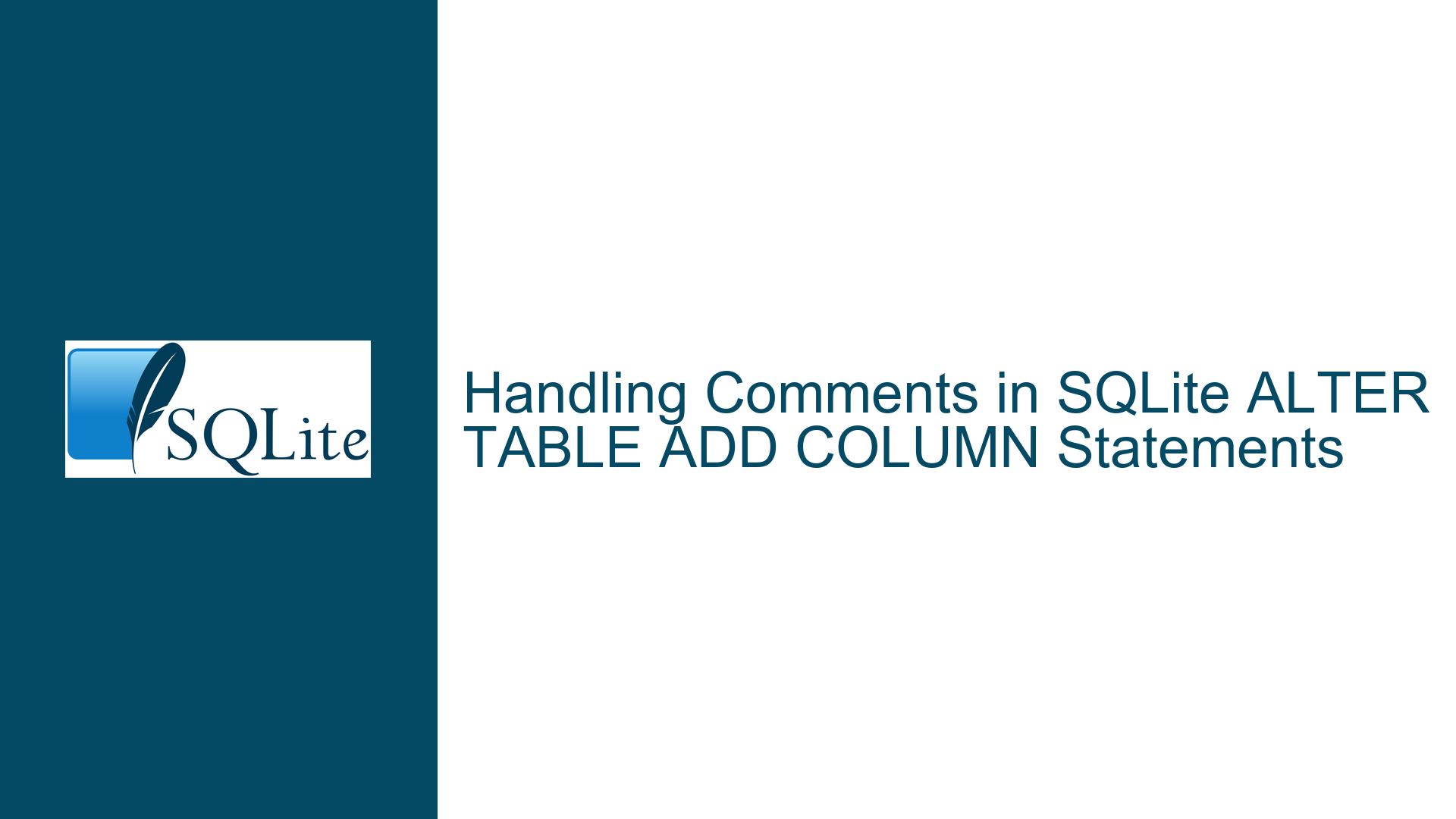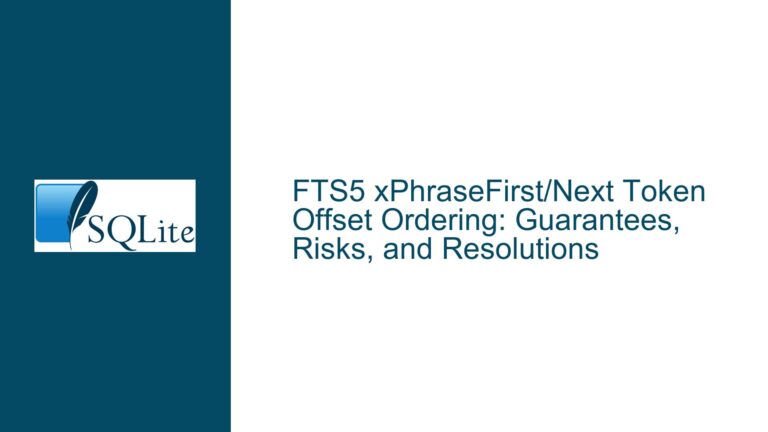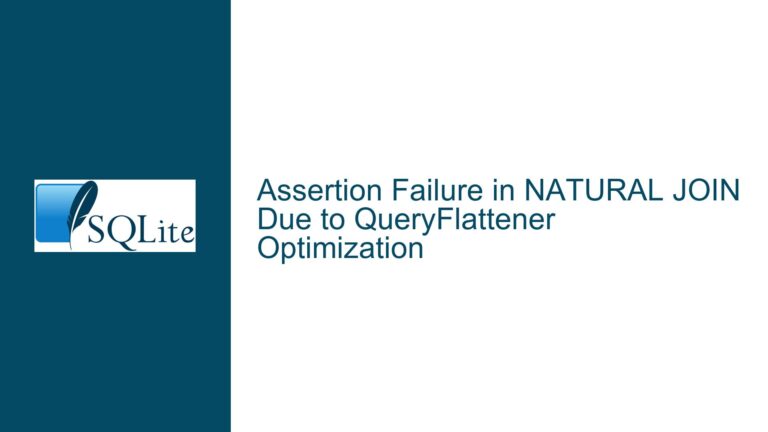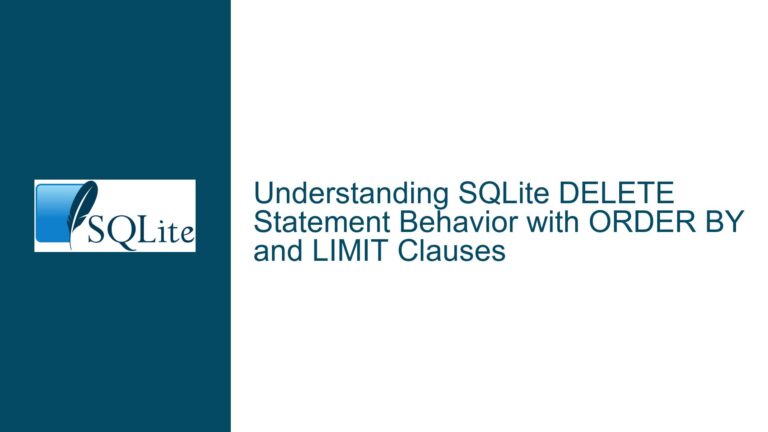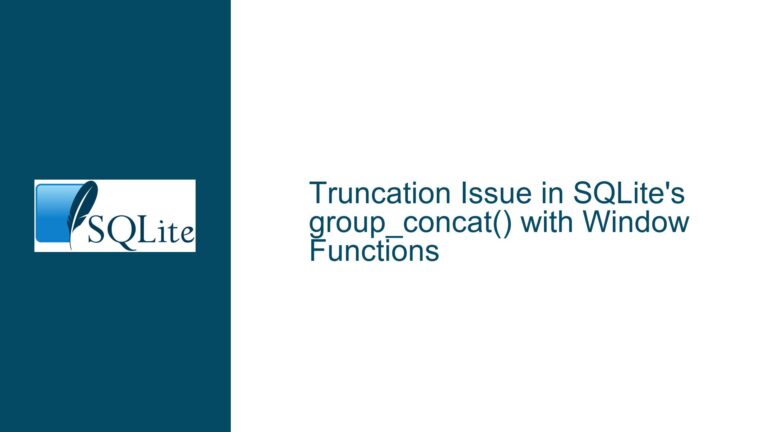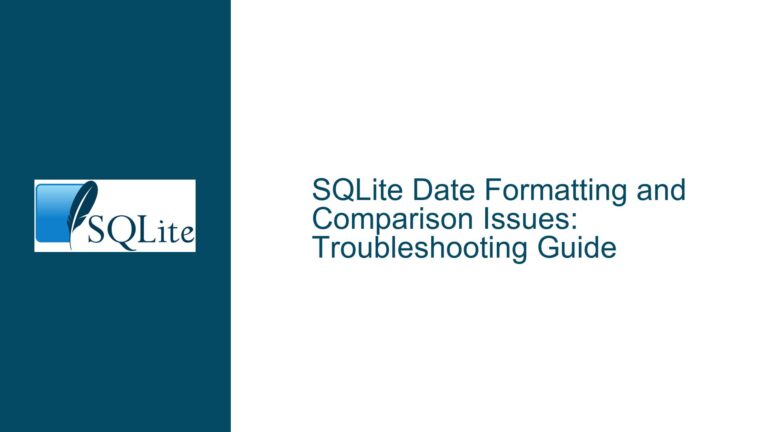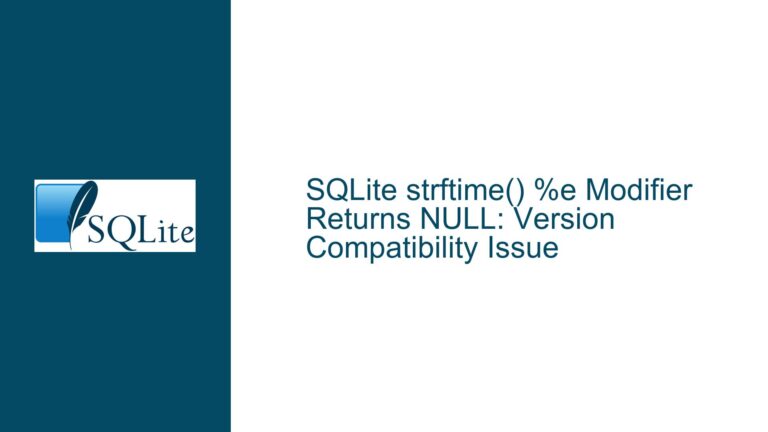Handling Comments in SQLite ALTER TABLE ADD COLUMN Statements
Understanding Comment Retention in SQLite Schema Modifications
The ability to embed comments directly within Data Definition Language (DDL) statements is a common practice for documenting database schemas. However, SQLite exhibits specific behavior when handling comments in ALTER TABLE ADD COLUMN statements that can lead to confusion and unexpected results. This guide dissects the intricacies of comment handling during schema modifications, explores the root causes of observed inconsistencies, and provides actionable solutions for maintaining comment integrity in SQLite databases.
Behavior of Comments in ALTER TABLE vs. CREATE TABLE Statements
The Core Issue: Discrepancy in Comment Preservation
When modifying an existing table in SQLite using ALTER TABLE ADD COLUMN, users often attempt to document new columns by appending SQL-style double-hyphen (--) comments to the column definition. However, these comments are not preserved in the database schema, unlike their behavior in CREATE TABLE statements. Consider this example:
-- Attempting to add comment via ALTER TABLE
ALTER TABLE Loan ADD COLUMN Interest Real -- bimonthly rate of interest;
While this syntax executes without errors, querying sqlite_schema reveals the comment is absent from the stored DDL. Contrast this with column comments in CREATE TABLE statements:
CREATE TABLE Loan (
Interest Real -- bimonthly rate of interest
);
Here, the comment persists in the schema. This inconsistency stems from fundamental differences in how SQLite processes DDL statements during table creation versus alteration.
Technical Demonstration of the Phenomenon
CREATE TABLE Behavior
Column comments using both comment styles are preserved:CREATE TABLE test ( col1 INTEGER /* C-style comment */, col2 TEXT -- SQL-style comment );Schema storage:
CREATE TABLE test ( col1 INTEGER /* C-style comment */, col2 TEXT );ALTER TABLE Behavior
Only C-style comments survive schema storage:ALTER TABLE test ADD COLUMN col3 REAL /* C-style survives */; ALTER TABLE test ADD COLUMN col4 BLOB -- SQL-style disappears;Resulting schema:
CREATE TABLE test ( col1 INTEGER /* C-style comment */, col2 TEXT, col3 REAL /* C-style survives */ );
Impact on Schema Documentation
This behavior undermines documentation efforts when evolving database schemas. Teams relying on inline comments for column descriptions face information loss during iterative schema changes, potentially leading to:
- Misinterpretation of column purposes
- Increased onboarding time for new developers
- Difficulty auditing schema changes over time
SQLite Parser Mechanics and Comment Handling Differences
Phase 1: Tokenization and Comment Stripping
SQLite’s SQL parser operates in distinct phases when processing statements:
Tokenization
The input stream is broken into tokens (keywords, identifiers, literals, etc.). During this phase:- C-style comments (
/* ... */) are treated as whitespace but preserved in the token stream - SQL-style comments (
-- ...) are stripped entirely, including the trailing newline
- C-style comments (
Syntax Tree Construction
The parser builds an abstract syntax tree (AST) from the token stream. At this stage:- C-style comments attached to column definitions become part of the AST
- SQL-style comments have already been removed and do not influence the AST
Phase 2: Schema Storage Mechanics
When persisting DDL statements to sqlite_schema:
CREATE TABLEstatements store the original SQL text with all preserved tokensALTER TABLE ADD COLUMNgenerates new SQL text by reconstructing the statement from the AST
This implementation detail explains the behavioral divergence:
CREATE TABLE Preservation
Original SQL text (including comments) is stored verbatim because:- The entire statement is parsed as a single unit
- Comments exist in the token stream when the schema entry is created
ALTER TABLE Reconstruction
The new column definition is synthesized from the AST:- SQL-style comments were stripped during tokenization and don’t exist in the AST
- C-style comments remain as whitespace tokens in the AST and are included in reconstruction
Code-Level Analysis
Examining SQLite’s source code reveals key implementation details:
ALTER TABLE Processing (
alter.c)
Thesqlite3AlterFinishAddColumnfunction constructs the modifiedCREATE TABLEstatement by:- Appending the new column definition to the existing schema
- Stripping trailing semicolons and whitespace from the column definition
/* From alter.c */ while( zEnd>zCol && (*zEnd==';' || sqlite3Isspace(*zEnd)) ){ *zEnd-- = '\0'; }This truncation inadvertently removes SQL-style comments that might have been preserved through earlier processing stages.
Parser Token Handling (
parse.y)
The grammar rules forALTER TABLEexplicitly calculate column definition length excluding trailing tokens:Y.n = (int)(pParse->sLastToken.z-Y.z) + pParse->sLastToken.n;This calculation fails to account for SQL-style comments that extend beyond the last parsed token.
Strategies for Effective Comment Preservation and Schema Documentation
Solution 1: Leverage C-Style Comments in ALTER Statements
While SQL-style comments are stripped during ALTER TABLE processing, C-style comments survive schema reconstruction:
-- Recommended syntax
ALTER TABLE Loan ADD COLUMN Interest Real /* bimonthly rate of interest */;
Implementation Notes:
- Place comments immediately after the column definition
- Avoid nested comments (
/* /* nested */ */) which cause parse errors - Ensure comment termination to prevent statement truncation
Verification Method:
-- Check stored schema
SELECT sql FROM sqlite_schema WHERE name = 'Loan';
Solution 2: Schema Comment Meta-Table Approach
For complex documentation needs, implement a dedicated comment storage system:
-- Create metadata table
CREATE TABLE schema_comments (
object_type TEXT CHECK(object_type IN ('table', 'column')),
object_name TEXT,
comment TEXT,
PRIMARY KEY (object_type, object_name)
);
-- Store column comment
INSERT INTO schema_comments VALUES
('column', 'Loan.Interest', 'Bimonthly rate of interest');
Advantages:
- Enables rich documentation with history tracking
- Supports internationalization through multiple comment translations
- Allows programmatic access via application code
Querying Documentation:
-- Retrieve column comments with table structure
SELECT m.object_name, m.comment
FROM schema_comments m
WHERE m.object_type = 'column';
Solution 3: SQLite Schema Dump and Reconstruction
When using SQL-style comments is mandatory, employ a dump/reload strategy:
Generate schema dump:
sqlite3 database.db .schema > schema.sqlManually edit
schema.sqlto add comments:CREATE TABLE Loan ( -- ... existing columns ... Interest Real -- bimonthly rate of interest );Reload the modified schema:
sqlite3 new_database.db < schema.sql
Cautionary Notes:
- Breaks existing
rowidassignments for tables without explicit primary keys - Requires careful handling of attached databases and temporary objects
- May necessitate data migration for complex schemas
Solution 4: Custom Build with Parser Modifications
For organizations requiring strict SQL-style comment support, consider patching SQLite’s source:
Modify
parse.yGrammar Rules:- Y.n = (int)(pParse->sLastToken.z-Y.z) + pParse->sLastToken.n; + Y.n = (int)(pParse->sLastToken.z-Y.z);Adjust
alter.cTruncation Logic:- while( zEnd>zCol && (*zEnd==';' || sqlite3Isspace(*zEnd)) ){ - *zEnd-- = '\0'; - }
Compilation Steps:
# Obtain SQLite amalgamation
wget https://www.sqlite.org/src/tarball/sqlite.tar.gz
tar xzf sqlite.tar.gz
# Apply patches to parse.y and alter.c
# ... (apply modified code from forum discussion) ...
# Compile custom build
gcc -DSQLITE_ENABLE_UPDATE_DELETE_LIMIT \
-DSQLITE_ENABLE_COLUMN_METADATA \
shell.c sqlite3.c -lpthread -ldl -o sqlite3-custom
Deployment Considerations:
- Maintain strict version control for custom builds
- Validate against SQLite’s extensive test suite
- Monitor for upstream changes that might conflict with patches
Solution 5: Comment Preservation Wrapper Tools
Develop or utilize existing tooling to manage schema comments externally:
Schema Version Control System
Implement a Git-based tracking system that:- Stores raw
.sqlfiles with comments - Automatically strips comments during deployment
- Maintains comment history separately from database files
- Stores raw
ORM Annotation Integration
Leverage object-relational mapping systems that support schema comments:# SQLAlchemy example class Loan(Base): __tablename__ = 'Loan' interest = Column(Float, comment='Bimonthly rate of interest')CI/CD Pipeline Processing
Incorporate comment handling into deployment pipelines:# Example GitHub Actions step - name: Process SQL Comments run: | sed -e 's/--.*$/\/* & *\//' schema.sql > schema_processed.sql sqlite3 ${DATABASE} < schema_processed.sql
Best Practices for Robust Schema Documentation
Comment Style Standardization
Adopt team-wide conventions for SQL comment usage:- Reserve C-style comments for schema-persisted documentation
- Use SQL-style comments for transient query explanations
- Implement linter rules to enforce comment conventions
Schema Documentation Workflow
Establish processes that decouple documentation from DDL execution:- Maintain separate
COMMENT ONstatements (though not natively supported in SQLite) - Use version-controlled markdown files alongside schema definitions
- Integrate with data dictionary generation tools
- Maintain separate
Automated Schema Validation
Implement checks to verify comment preservation:# Python validation example import sqlite3 def validate_comments(db_path): conn = sqlite3.connect(db_path) cursor = conn.cursor() # Verify ALTER TABLE comments cursor.execute("SELECT sql FROM sqlite_schema WHERE name='Loan'") schema = cursor.fetchone()[0] assert '/* bimonthly rate of interest */' in schemaDatabase Visualization Tool Integration
Utilize tools that parse SQLite schemas and display comments:- DB Browser for SQLite: Manually inspect schema SQL
- SQLiteStudio: Generates ER diagrams with comment annotations
- Custom Scripts: Extract comments to HTML/PDF documentation
By understanding SQLite’s comment processing mechanics and implementing these strategic solutions, teams can effectively maintain comprehensive schema documentation while accommodating SQLite’s specific behavioral characteristics. The choice between comment styles, external documentation systems, and potential source modifications should be guided by project requirements, team workflow preferences, and long-term maintainability considerations.
